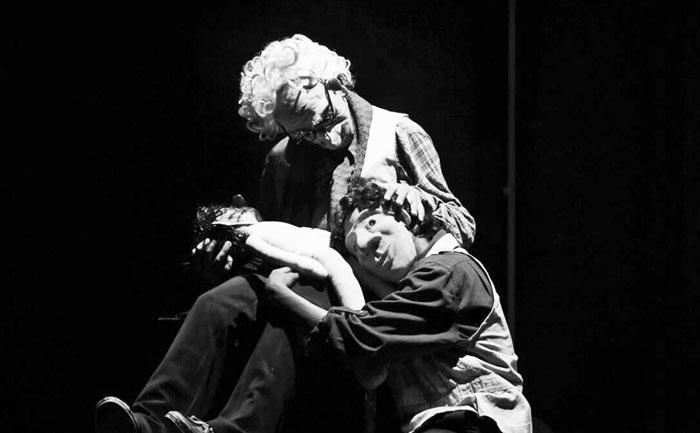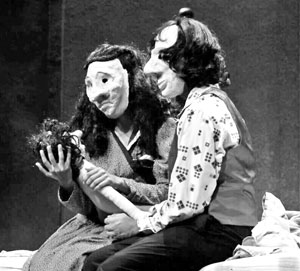
The deepest human emotions are possibly the ones that defy the limits of words. Young theatre director S. I. Samarakkody through his nonverbal stage play, Love and Life, presents a theatrical narrative, devoid of dialogue but abundant in meaningful communication. I watched this delightful work of theatre unfold on August 20, at the Panibharatha Theatre, University of Visual and Performing Arts.
A work of cinema that has no dialogue is called a silent film. But, is it completely ‘soundless’? The audio element –as/of music in a silent film could technically argue otherwise. On the matter of how dialogue is made of verbal expression that takes the form of the ‘spoken word’, does the total absence of dialogue constitute a state of wordlessness? I pondered on that thought when looking into the mode of narrative adopted by Samarakkody in narrating a heart-warming story woven around how love takes different forms and turns, in the life of a family of three. By and large the basis of this drama is of a wordless approach. But at the point when the old lady (the mother) spreads out a scarf she had been knitting for a contest, which carry the words ‘Love and Life’ I would argue on the basis of words being displayed visually, may, perhaps pose a contradiction to the label ‘wordless play’ if one were to call it wordless, since such a visual impression may validly form a presence of the ‘written word’ although no ‘verbal words’ are at play. However, despite having zero dialogue this play which is not by any means devoid of audio elements proves to be entertaining, engaging and captivates the audience by addressing emotions and issues that relate to the theme of love and caring for each other as bonds that build familial life.
Narrative
Accordion music runs along many a juncture while a Hindi pop number also comes on at the early part of the play. The narrative builds much of its situations and emotions in tandem with the music and audio elements to convey the thought and feeling embedded in the scenario on stage. A remarkable facet of this work is the host of characters who come on stage to create the vibrant fabric of performance wear what look like papier-mâché masks. Every character has a distinct identity and a total of sixteen characters are portrayed on stage by three actors. It proves, in my opinion, a feat to celebrate and applaud; as the skill and resourcefulness of the acting and directorial talents together stand tall through this performance.
 There is, I felt, something of the Sinhala ‘Kolam’ folk drama tradition given how the use of stylised masks coupled with gestures that signpost/signify nonverbal expressions gave reminiscence of performances like the ‘Nonchi Kolama’ which is of the Kolam tradition of Sri Lanka. But Love and Life does not, I believe, by any means present a ‘modernised Kolama’ as such, lest my comments were to be construed that way. Among other things the play shows the power of wordless expression, where a face moulded to project a particular vintage and ‘bearing’ complemented with certain physical/bodily gestures and pace of movement, can deliver a sense of universality in communication beyond verbal language.
There is, I felt, something of the Sinhala ‘Kolam’ folk drama tradition given how the use of stylised masks coupled with gestures that signpost/signify nonverbal expressions gave reminiscence of performances like the ‘Nonchi Kolama’ which is of the Kolam tradition of Sri Lanka. But Love and Life does not, I believe, by any means present a ‘modernised Kolama’ as such, lest my comments were to be construed that way. Among other things the play shows the power of wordless expression, where a face moulded to project a particular vintage and ‘bearing’ complemented with certain physical/bodily gestures and pace of movement, can deliver a sense of universality in communication beyond verbal language.
The play shows an old couple’s dotage and their life in flashbacks while indicating that dotage is like a second childhood when love binds them together. Love and Life shows several kinds of love. Parental love is seen without reservation, spousal love is seen endearingly, but filial love is painfully amiss. The old couple’s life as it builds up through various dramatic stages is played out through reminiscences and flashbacks. Their love is never in question but the question of filial love is highly contestable since till the very end –where the mother too has passed away, there is no sign of filial love in their life. The miscreant son however finally realises his callousness on arriving at fatherhood himself.
That final moment shows how unbounded true parental love can be, how ungrudgingly forgiving parents can be to their children, no matter which vintage they be, since the parent-child relationship is not conditioned by expiration dates.
Undergarment
In a particular scene a cross dresser/pansy gropes the old man frisking him to check if an item of undergarment had been stolen by him. The character of the old man was thus clearly subjected to sexual harassment. I felt personally glad that no one in the audience found it amusing to laugh at, that evening. Generally, that may seem like a ripe moment for audiences who are poised to embrace comedy for the sake of laughing.
A noteworthy matter about this play is that costumes did not expressly denote a Sri Lankan setting for the story. The only exception being the ice-cream vendor who wore a sarong. The other indication that allows the play to be read as a Sri Lankan story is when the daughter-in-law worships her father-in-law.
Due to a few facets that depict sex and sexuality related matters I wonder if Love and Life can be considered a play suitable for the entire family, especially in respect to prepubescent children. However, the relevance of this play’s message about how filial love must be deeply thought about in today’s society is undeniable. Love and Life is one of those rare gems of theatre that speak unforgettably to our heart and pulse; without saying anything at all.
